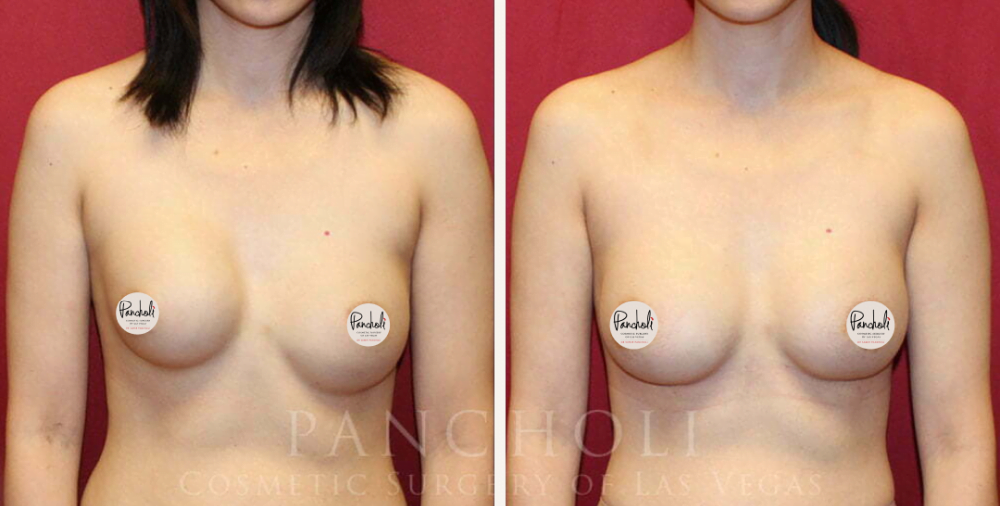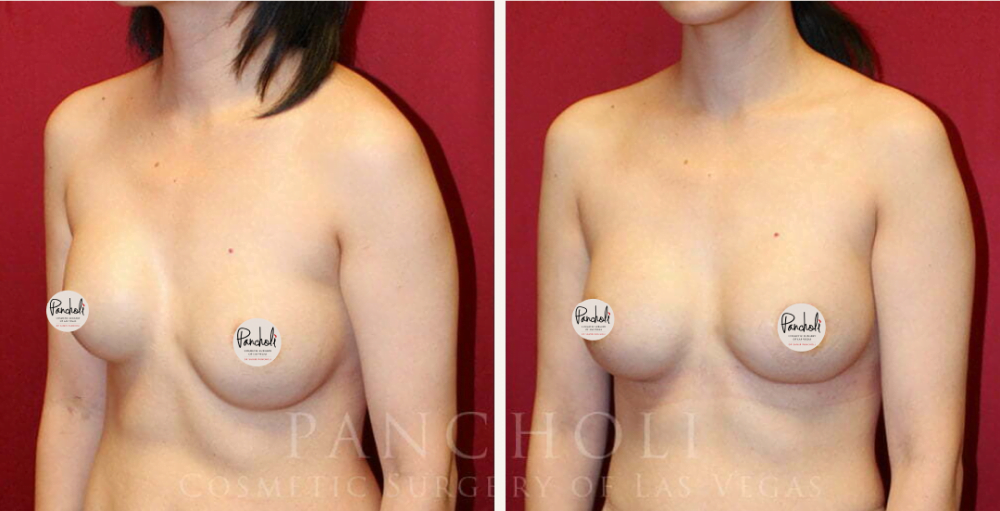Breast Implant Revision Surgery in Las Vegas
Ideally, every breast augmentation patient would get exactly what she wants the very first time. While this is often the case, sometimes results aren’t as expected. Even superb results will change over the years, and sometimes it’s just time for an update or implant upgrade. Whatever your reasons for considering breast implant revision, Dr. Pancholi can help. Patients come to him from across the globe for his experience and expertise in revision breast procedures, and he is known for achieving beautiful improvements even for challenging cases.
- Can Revision Breast Surgery Help Me?
- Why Choose Dr. Pancholi?
- What Problems Can Revision Surgery Correct?
- How Can I Make Sure I Get the Improvements I Want?
- Will Insurance Cover Breast Implant Revision Surgery?
- Schedule Your Personal Consultation

Can Revision Breast Surgery Help Me?
With any surgery, the risk exists for less-than-ideal results. If you are considering breast implant revision surgery, know that it doesn’t mean you did anything wrong the first time you had breast augmentation.
Whether or not complications stem from having surgery performed by a less experienced surgeon, receiving misguided advice for sizing, pregnancy, weight changes, aging, or just sheer luck, you didn’t do this to yourself. With the right cosmetic surgeon, chances are that with revision surgery you will be able to get the beautiful results you were hoping for the first time around.
Why Choose Dr. Pancholi?

As a fellowship-trained cosmetic surgeon, a diplomate of the American Board of Cosmetic Surgery, and a specialist in breast implant revision, Dr. Samir Pancholi has helped hundreds of women in Las Vegas correct problems with their implants through individualized breast implant revision surgery. He is known for his precision, artistry, and attention to detail.
In fact, his motivation to specialize in breast surgery grew from the realization that a lot of women in Las Vegas were unhappy with their results from less experienced surgeons. Dr. Pancholi finds revision surgery especially rewarding, as his patients regain confidence in their appearance and finally see the results they hoped for with breast enhancement.
Before & After View Patient Results & Save Your Favorites >“I LOVE LOVE LOVE Dr. Pancholi and his staff!! I have lived here in Vegas for over 15 yrs and I am serious and honest when I say Dr. Pancholi is the BEST! I am 3 months in healing after he replaced my ruptured implant and I feel amazing! He was a day-and-night difference to my previous surgeon. Dr. Pancholi takes his time, he is a perfectionist, and his staff is so welcoming and caring! I will not use any other surgeon for my cosmetic needs, he gave me back my security and I will forever thank and appreciate him!”
—C.H.P., breast revision patient
Read more of Dr. Pancholi’s reviews
Video transcript
“One of the things that really sets us apart from other practices is the amount of breast surgery that we do, and really, the complexity of it. When we look at fixing breast augmentations, breast lifts, reductions, and everything else, it’s about having the ability and the tools to do it. But the bigger part is, do you have someone with the aesthetic eye to put things back together? And that would be another reason that you want to come here. We’re doing this all with an artistic approach. We’re looking at your body, your frame, and what truly fits you. Our recommendations will hopefully help you get the figure that you want and the confidence that you want back in yourself.”—Dr. Samir Pancholi
What Problems Can Revision Surgery Address?
Whether you desire a size change or are experiencing asymmetry, deflation, or a complication from surgery, Dr. Pancholi can help you address your concerns. Some of the most common reasons for implant revision include:
- Breast Implant Deflation
- Implant Malposition (poorly placed or asymmetrical implants)
- Capsular Contracture
- Desire for Size Change

- Key Benefits
- Glossary
- Updated implant size or shape
- Correction of complications
- Improved breast symmetry
- Switching implant type
- Anesthesia: Medications used to prevent pain during surgery; can be general (inducing unconsciousness) or local (numbing a specific area).
- Breast Implant Illness (BII): A term used to describe a variety of symptoms thought to be potentially associated with breast implants, such as fatigue, chest pain, hair loss, and headaches.
- Capsular Contracture: A complication of breast augmentation where scar tissue forms around the implant, causing firmness, distortion, and sometimes pain.
- Capsulectomy: The surgical removal of the capsule of scar tissue formed around a breast implant.
- Capsulotomy: A surgical procedure that involves scoring, cutting, or releasing the capsule of scar tissue surrounding a breast implant to relieve tightness and improve comfort.
- Double Bubble Deformity: A complication where the implant sits below the natural fold of the breast, creating a double-contour appearance.
- Implant Exchange: The replacement of old breast implants with new implants.
- Implant Malposition: When a breast implant moves from its original position, causing asymmetry or distortion.
- Inframammary Fold Incision: An incision made in the natural crease under the breast, commonly used in breast implant revision surgeries.
- Mastopexy: The medical term for a breast lift, a procedure that may accompany implant revision to correct sagging.
- Pocket Revision: Surgical adjustments to the pocket that holds the breast implant, to correct implant position or change implant size.
- Rippling: Visible or palpable wrinkling of the implant seen on the skin surface, often a reason for implant revision.
- Rupture: A tear or hole in the implant’s outer shell, which can occur in both saline and silicone implants.
- Scar Tissue: Fibrous tissue that forms as a natural part of the healing process following surgery or injury. In the context of breast implants, it can sometimes form a tight or thick capsule around an implant, leading to discomfort or aesthetic concerns.
- Seroma: A collection of fluid that builds up under the surface of the skin, particularly around an implant or incision site.
- Subpectoral Plane: A placement of breast implants beneath the pectoral muscle, also known as a submuscular placement. This positioning can impact the appearance and feel of the breast implant.
- Symmastia: A rare complication where implants are placed too close together, creating the appearance of a single large breast.
- Symmastia Correction: A surgical procedure to correct symmastia, restoring the natural separation between the breasts.
How Can I Make Sure I Get the Improvements I Want?
Many factors are involved in improving the overall appearance of breast implants. While it’s always important to choose a cosmetic surgeon with experience in the procedure you are having, this is especially true for breast implant revision. Since your breast tissue has already been altered, you need a cosmetic breast surgeon who has the knowledge and surgical skill to achieve optimal results for your unique circumstances.
To make the necessary improvements, Dr. Pancholi takes into consideration a multitude of factors, including:
- The type of breast implant used in your initial augmentation
- How much breast tissue you have
- Skin integrity
- Your current weight, chest and ribcage contour, and proportions
- Placement and position of the breast implant
- How many breast surgeries you’ve had already
Having performed many hundreds of breast revision procedures, Dr. Pancholi has the experience, knowledge, and tools to achieve dramatic improvements even for more challenging cases.
Video transcript
“We can help augment the size of the breast after we take the implants out, and often, we do that with fat transfer. That means we liposuction a certain area of the body and take that fat to transfer it to the breast to create a fuller or at least more voluminous breast.
Other reasons that people are taking their implants out can be that they are experiencing some level of symptomatology from their implants. This is something people call breast implant illness, and I believe it exists. I think there is a certain set of symptoms that continue to show up, and when the implants are removed, people seem to improve significantly from this.
Now, the caveat to this is that there is not a test that we can use to diagnose this. It’s not like you can take a test that will tell you definitively if you have breast implant illness. These are essentially diagnoses that are made when we haven’t been able to find another reason for the symptoms, and when we take the implants out, and people get better, this is what’s referred to as breast implant illness, or at least how we can diagnose or attribute it.”–Dr. Samir Pancholi
Whenever indicated, he will remove breast implants en bloc, which means he removes the scar tissue (capsule) and implant in one piece, with the implant still sealed inside. This ensures that all old breast implant matter is removed during surgery before a new implant is placed.
In many cases, he will incorporate Strattice Tissue Matrix to add coverage and support to weakened or thin breast tissues. Learn more about how Dr. Pancholi uses Strattice for breast revision surgery »
Video transcript
“One of the interesting things that has come into play recently is the use of mesh in breast surgery. So, why do we use mesh, and what is it for? One of the main reasons for using mesh is when we want to place an internal bra to help support and maintain the position of the implants.
What does this mean? Well, we know that when we put an implant inside the body, the implant is heavy. Imagine if you had a hammock at home, and you just hired the Michelin Man to sit on it. The hammock would stretch out. What we want to do is make that hammock much stronger, so it can hold your implant up. For individuals with either weak chest muscles from lack of exercise or muscles that have been stretched out from larger implants, we might want to reinforce the bottom of the breast to help support the implant.
Another primary reason for using mesh is when we need to improve the position of the implant. For instance, if your implants have come together in the middle, and we don’t want them to, we’ll place mesh on each side to separate them. If they’ve shifted off to the side, we’ll lift the implant back into the middle and reinforce the sides. If they’ve sagged too far down, we’ll reinforce the bottom. Mesh is used to reinforce various areas of the breast to provide stability in the implant’s position over time. This prevents the skin from stretching out again and the implants from shifting back to their original positions.
The great thing about using mesh is that it provides stability over time. The downside is that you may be able to feel it initially as your body incorporates it into its tissue. Eventually, it all dissolves and gets replaced by strong scar tissue on the inside, which you can’t feel. However, in the beginning, you might be able to sense it until your body fully incorporates it.”–Dr. Samir Pancholi
Will Insurance Cover Breast Revision Surgery?
As breast augmentation is considered a cosmetic procedure, your health insurance will probably not cover breast implant revision. However, both breast implant manufacturers that Dr. Pancholi utilizes, Allergan and Mentor, offer basic and premium lifetime product warranties on their breast implants for every patient who has their gummy bear, silicone gel, or saline implants. The basic warranty covers the cost of new breast implants should yours deflate or rupture.
Learn about breast implant warranties

If you are experiencing problems with your breast implants with another surgeon, we invite you to schedule a consultation with Dr. Pancholi. During this meeting, he will listen to your concerns, answer your questions about what’s involved in breast implant revision, and discuss all your options to help you get the results you desire.
References »
Navanjun S. Grewal, Jack Fisher, Why Do Patients Seek Revisionary Breast Surgery?, Aesthetic Surgery Journal, Volume 33, Issue 2, February 2013, Pages 237–244, https://doi.org/10.1177/1090820X12472693
Forster NA, Künzi W, Giovanoli P. The reoperation cascade after breast augmentation with implants: what the patient needs to know. Journal of Plastic, Reconstructive & Aesthetic Surgery. 2013 Mar;66(3):313-22. doi: 10.1016/j.bjps.2012.09.033.
Spear SL, Low M, Ducic I. Revision augmentation mastopexy: indications, operations, and outcomes. Annals of Plastic Surgery. 2003 Dec;51(6):540-6. doi: 10.1097/01.sap.0000096450.04443.be.
Clough R, Darragh L, Maclennan L, O’Donoghue JM. Revision Surgery to Improve Cosmesis with Immediate Implant-Based Breast Reconstruction. JPRAS Open. 2021 May 21;29:106-112. doi: 10.1016/j.jpra.2021.04.006.

